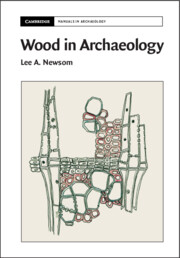Book contents
- Wood in Archaeology
- Cambridge Manuals in Archaeology
- Wood in Archaeology
- Copyright page
- Dedication
- Contents
- Plates
- Figures
- Tables
- Preface
- Acknowledgments
- 1 Introduction
- 2 Archaeological Wood
- 3 Woody Plants
- 4 Wood Anatomy Basics
- 5 Working with Archaeological Wood
- 6 Working with Archaeological Wood
- Book part
- Bibliography
- Index
4 - Wood Anatomy Basics
Published online by Cambridge University Press: 02 April 2022
- Wood in Archaeology
- Cambridge Manuals in Archaeology
- Wood in Archaeology
- Copyright page
- Dedication
- Contents
- Plates
- Figures
- Tables
- Preface
- Acknowledgments
- 1 Introduction
- 2 Archaeological Wood
- 3 Woody Plants
- 4 Wood Anatomy Basics
- 5 Working with Archaeological Wood
- 6 Working with Archaeological Wood
- Book part
- Bibliography
- Index
Summary
This chapter details and explains wood anatomy, including the fundamental distinctions between hardwoods, or flowering plants, and softwoods, mainly the conifers. The principal cell types and defining characteristics of secondary xylem are described, with emphasis on the details and traits most relevant to wood identification and work with archaeological wood. The second half of the chapter reviews well-documented variability in anatomical expression that may result from a wide range of internal and external stimuli, including delving further into functional and ecological variation (i.e., juvenile wood, reaction wood, such as were initially described in Chapter 3). The deliberate and secondary effects of human activities influencing wood development and woodland resources generally are also examined.
- Type
- Chapter
- Information
- Wood in Archaeology , pp. 93 - 152Publisher: Cambridge University PressPrint publication year: 2022

